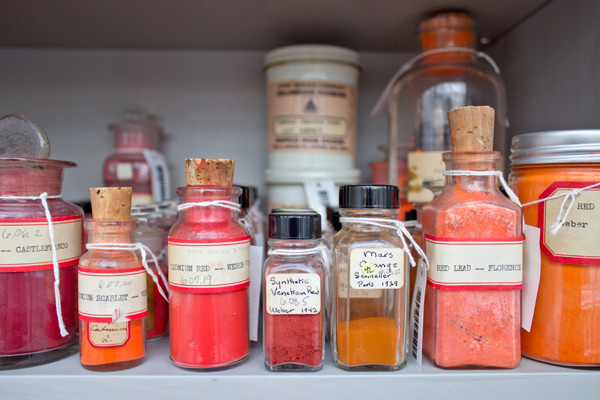A large rock of lapis lazuli from Afghanistan, a rare group of pigments from Japan, fluorescent Day-Glow pigments: these are just some of the treasures housed in the long row of cabinets in the Harvard Art Museums’ Straus Center for Conservation and Technical Studies. The cabinets, situated within the glass-walled analytical laboratory overlooking the Calderwood Courtyard, contain the Straus Center’s remarkable materials collection—made up of pigment samples, binding media, raw materials samples, historical scientific equipment, and a group of stone and mineral samples taken from buildings of antiquity.
Prior to the renovation and expansion of the museums, the bulk of these materials had been stored away from public view. It took two moving trucks to relocate the more than 3,600 catalogued samples from their off-site location, many of which are stored in their original delicate glass containers.
Narayan Khandekar, senior conservation scientist, had a number of factors to consider while devising a layout for the collection. Given that it is visible throughout the museums’ core space, “it was important that the collection look good from a distance, as well as close up,” he explained. “These materials serve as an active reference for the laboratory, so it was also essential that the installation be informative and include the collection’s historical aspects.”
Khandekar cleverly used an artist’s color wheel as his reference for installing the collection, with yellow as the central organizing color. The pigment samples, some of which date back more than a hundred years and come from all over the world, fan out horizontally in a stunning display of sequenced hues. The cabinet’s uppermost shelf showcases samples from the famed Forbes Collection of Pigments, which was assembled by former Fogg Museum director Edward W. Forbes. Modern pigment samples are located to the south of this core collection. The complex layout continues vertically on the cabinets’ lower levels, with samples of black and white pigments, pigments of tertiary colors, and pigments of like colors produced by different manufacturers. The bottommost shelf displays raw materials used to make pigments, such as weld, the weed used to make the yellow glaze seen in Dutch paintings.
Khandekar has taken special care to unite certain historical groupings in the collection, such as the Straus Center’s early scientific instruments. Among these is the extraordinary microsampler made by the Fogg Museum’s first staff scientist, Rutherford John Gettens. The instrument can take microscopic samples of paint that can then be made into a cross-section to analyze the paint’s stratigraphy. All of these instruments tell the story of how the center was early to adopt technology and served as a pioneer in the technical study of art. Also arranged in the cabinets are special groupings of pigments, such as a collection of ochres from Barcelona, which were given to the museum by Don Luis Plandiura in 1928. The north end of the display is filled with samples of binding media that Gettens collected.
In addition to offering a phenomenal display of color and a glimpse into the museums’ history, the collection is an evolving resource for conservators and researchers both at the museums and far beyond. Straus Center staff continuously add to the materials housed in the cabinets, regularly using the samples as a reference for identifying artists’ materials.





